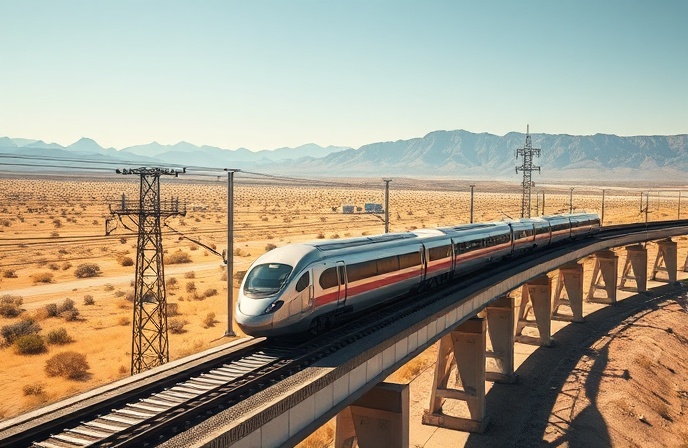ERTMS Deployment: Optimizing Global Rail Performance
Boost railway performance with ERTMS. Discover how advanced technologies optimize operations and enhance passenger experience.

Optimizing Railway Performance Through Advanced Technologies
The global railway industry is undergoing a period of significant transformation, driven by the need for enhanced safety, efficiency, and capacity. This evolution is fueled by a range of cutting-edge technologies, from sophisticated signalling systems to advanced train control mechanisms. This article will delve into the key factors impacting railway performance and explore how integrated technological solutions are revolutionizing the sector, focusing on the crucial role of ERTMS deployment (European Rail Traffic Management System) in modernizing rail networks worldwide. We will examine how these advancements improve operations, reduce costs, and ultimately enhance the passenger experience. The article will cover the importance of robust infrastructure, the role of reliable communication systems, and the integration of intelligent transportation technologies within a comprehensive framework to ensure safe, punctual, and efficient rail travel.
The Imperative for Enhanced Railway Infrastructure
Modern railway networks require a robust infrastructure foundation to support the introduction of advanced technologies. This involves upgrading track geometry, implementing precise ballast maintenance schedules, and ensuring consistent signaling infrastructure. Maintaining optimal track conditions reduces friction, minimizes derailment risks, and increases the overall safety and reliability of the system. Furthermore, robust communication networks, employing fiber optic cabling and advanced radio technologies, are essential for transmitting real-time data on train locations, status, and track conditions to control centers. The interplay between efficient infrastructure and cutting-edge technologies creates a critical synergy for optimized rail performance.
The Role of Intelligent Transportation Systems
Intelligent Transportation Systems (ITS) are playing a pivotal role in enhancing the effectiveness of railway operations. This encompasses a range of applications, from real-time train tracking systems that provide accurate passenger information to dynamic train scheduling algorithms that adapt to fluctuating demand. Furthermore, onboard diagnostics and predictive maintenance tools for rolling stock minimize downtime and optimize operational efficiency. These systems enable proactive interventions, reducing the risk of equipment failures and minimizing delays. Integration of these systems with centralized control and management platforms allows for comprehensive monitoring and control of the entire railway network.
Introducing ERTMS Deployment for Enhanced Safety and Efficiency
The implementation of ERTMS (European Rail Traffic Management System) represents a significant leap forward in railway automation. ERTMS enhances the safety of railway operations by providing a centralized, real-time command structure and control of train movements. Its use of automatic train protection systems ensures train speeds are always within permissible limits. This leads to an appreciable reduction in the risk of accidents. Furthermore, the data collected by ERTMS enables meticulous analysis of train operations, which facilitates optimization of schedules and routes, ultimately enhancing the efficiency and productivity of the railway network. By minimizing delay-causing incidents, ERTMS dramatically improves the reliability of rail services and ultimately contributes to enhancing the passenger experience. Detailed train monitoring ensures proactive maintenance and minimizes unexpected delays.
Conclusion: Shaping the Future of Rail Travel Through Technological Integration
The transformation of railway systems is driven by a complex interplay of infrastructure enhancements, intelligent transportation technologies, and the progressive deployment of advanced systems like ERTMS. The integration of these elements creates a synergy that dramatically improves the overall performance and safety of railway networks worldwide. Upgrading and integrating these components collectively leads to a considerable reduction in operational costs and an enhanced passenger experience, resulting in increased patronage. Ultimately, the implementation of ERTMS, alongside robust infrastructure, communication systems, and sophisticated ITS, paves the way for more efficient, reliable, and safe rail travel. The focus on these advancements is critical to the sustained growth and development of the railway industry in the 21st century, fostering seamless and efficient transport systems for individuals and businesses. By prioritizing the integration of technology throughout all aspects of railway operations, the future of rail travel will be characterized by greater capacity, punctuality, and improved safety. This technological evolution offers a pathway to a more efficient, sustainable, and interconnected global transport system.
ERTMS deployment is demonstrably crucial to modernizing railway operations, fostering a safe, efficient, and reliable rail network, which is crucial for the future growth of the industry. Optimizing railway performance is a multifaceted endeavor that requires a holistic strategy encompassing technological advancements in infrastructure, communication, and control systems. This approach guarantees enhanced safety, reliability, and efficiency, creating a positive passenger experience, which is integral for the sustainability and future growth of the railway industry.
You might be interested in:





